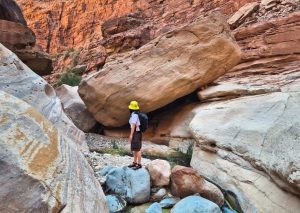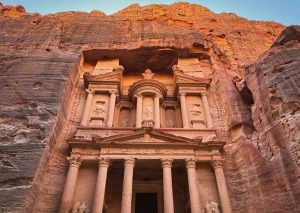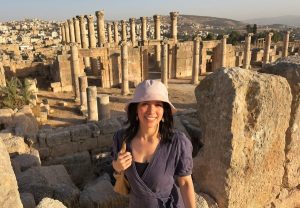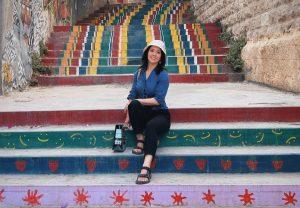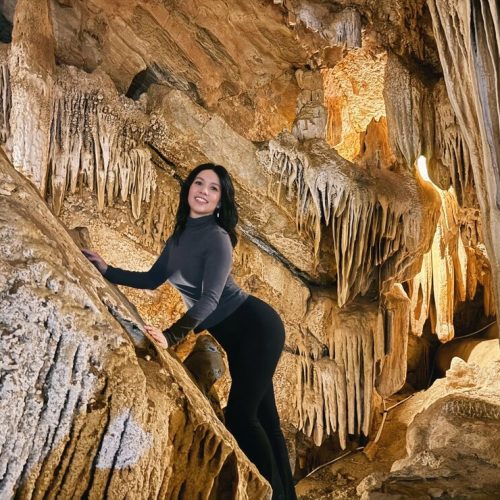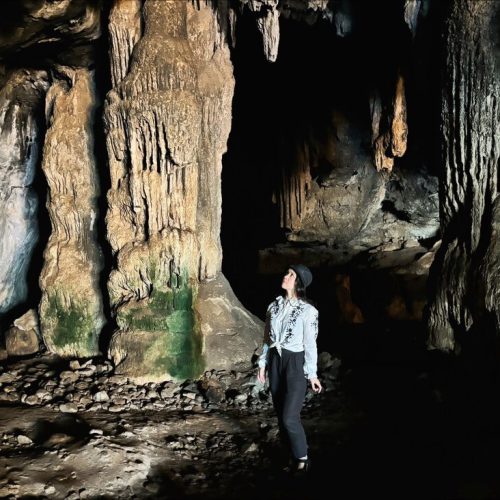
As much as I like Amman, I love its nearby attractions even more. Among them is Jerash, a Greco-Roman archeological site located just 30 miles north of the capital. It is so incredibly well-intact that few places today can capture in such detail the empires that once built, ruled, and fell before leaving their mark.
You can walk from Greek foundations to Roman theatres and Byzantine mosaics, all within a few steps. I firmly believe that no trip to Jordan is complete without heading up to Jerash so I’ve put together this short guide to convince you that it’s absolutely worth visiting.
A guide to visiting Jerash

The journey from Amman
Leaving Amman, the maze of concrete and chaos fades into the distance. The landscape ahead starts to look more green and fertile. It’s where the olive trees grow.
The 45-minute car journey passes quickly, especially in comparison to our long drives already spent down the Desert Highway and the Dead Sea Highway, both incredibly fitting names for such barren landscapes.
The numerous roadside shops selling locally-grown plants are a welcome change. So too are the occasional roadside stalls primed with beautiful ripe fruits. A glass of freshly squeezed pomegranate juice springs immediately to mind. I already know what I’ll be ordering when I arrive.
Soon enough the first monument – Hadrians Arch – appears from the roadside like a mirage. How? Why? What? Where? When? I had so many questions that needed answering. Such a striking Roman monument looked completely out of place in the Middle East.

Transport: My boyfriend and I rented a car, but Ubers are very common in Amman and much more affordable than in Europe. I recommend downloading the app to help you get around. However, they only operate in Amman so while you can get to Jerash by Uber, you’d need to catch a bus or taxi back.
Alternatively, there are a number of tours available from Amman to Jerash. A great option if you’d prefer to leave the logistics up to someone else.
Parking and entry free
We parked our car at the side of the road. Thankfully it was easy to park with lots of free space along the side of the Archeological site.
It’s free to enter if you purchased a Jordan Pass before entering the country. I highly recommend you do if you’re planning to be in Jordan for more than 4 days and visiting other sites like Petra. It also includes your visa. Otherwise, entry to Jerash archeological park is 12 JD.

Jerash – dubbed the “Pompeii of the East”
Some call it the “Rome of the East” and others ‘Pompeii of the East’. Neither are wrong. After a series of earthquakes and the decline of the Roman Empire, Jerash was gradually swallowed by the land.
Locals knew there were ruins here, but the full city wasn’t rediscovered until the 19th century, when a German explorer – Ulrich Jasper Seetzen – stumbled upon it. What you see today is the result of careful excavation that is still ongoing today.
The whole thing shimmers under the heat. Its colonnaded streets cutting through the dust like a mirage of another age. Jerash isn’t just “well-preserved for the Middle East” – it’s world-class.
I’ve been to many archeological sites around the world like Rome, Pompeii and the Acropolis, and it honestly sits up there with them, and since there were hardly any people in Jerash, I enjoyed my experience even more.
Jerash really is a city that has outlasted empires, earthquakes, and the stubborn passage of time, still standing proud in the northern hills of Jordan. If you arrive a bit later in the afternoon and stay until golden hour, the whole site is engulfed in the most beautiful white and gold light.

A city carved from empires
So how did it all begin? 2000 years ago this was Gerasa, a city of wealth and influence on the far edge of the Roman Empire. However, I learn that this place has been continuously inhabited for more than 6500 years but the Romans put it on the map so to speak.
Founded by the Greeks after Alexander the Great, it was later absorbed into Rome’s growing territory. During this time it flourished as part of the Decapolis – ten powerful cities bound by trade and culture.
Experts will be able to differentiate between the Greek remains and those built by the Romans, but not I. I wish I was that geeky. The only tell-tale sign for me were the occasional Greek letters I found inscribed into some of the stone ruins.
With Jerash being so well-preserved, your imagination doesn’t need to work too hard to envisage the city in full swing. Merchants haggled over spices, marble, and silk; chariots thundered down the Cardo Maximus, the 800-metre main street flanked by towering Roman columns.
This was the Middle East at its crossroads. A melting pot of Greek columns, Roman temples, Nabatean traders, and Arab artisans all moving through the same stone gates that we, the visitors, can still enjoy while retracing the steps of history.
Walking through history – the highlights
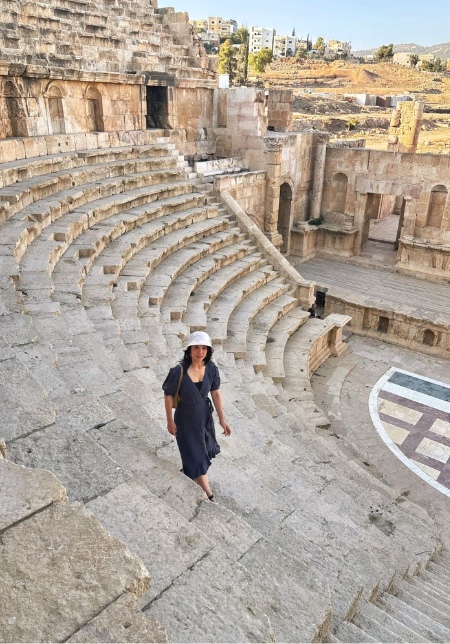
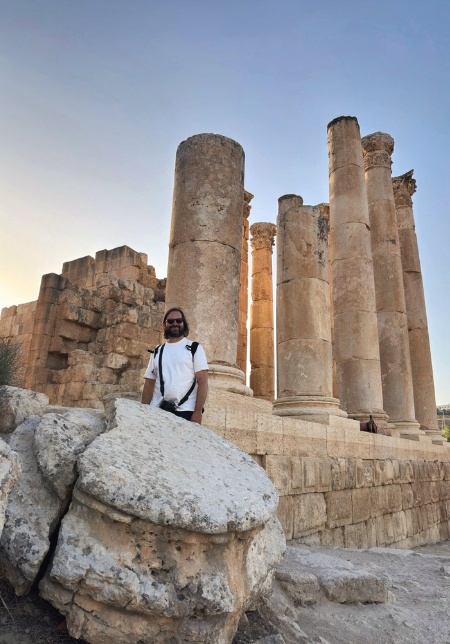
Hadian’s Arch | The entrance alone sets the tone. You walk beneath Hadrian’s Arch, built to honour the emperor’s visit in 129 AD.
Hippodrome | At nearly 245 metres long and 52 metres wide, it could seat around 15,000 spectators, though some estimates go higher. Re-enactments of various chariot related activities sometimes still take place here.
Oval Plaza | A vast, open space ringed with Ionic columns. The symmetry, the ambition, the sheer scale. It reminds me of a main square in Europe, serving the same purpose – a meeting point. A place for people to gather and perhaps where trades commonly took place.
Temple of Zeus | Perched on a rise above the Oval Plaza, this monumental temple holds commanding views over the valley.
South Theatre | Built around 100 CE, this 3000-5000 capacity venue is the larger of the two theatres. Look out for Yourself the bagpipe player!
Temple of Artemis | Like something out of a myth, it is said that animal sacrifices took place here at the highest point of Jerash. Dedicated to Artemis, the Greek goddess of wild animals, wilderness, hunting and childbirth.
Nymphaeum | As I stood looking out at this structure I couldn’t help but think of Tivoli Fountain in Rome. These types of structure were traditionally shrines to water Nymphs in classical Greek and Roman culture. There’s no water anymore, but the monument, with its lion heads, is highlight for sure.
North Theatre | Smaller and more intimate than its southern cousin, you can still imagine senators whispering, lovers meeting in the back row, and actors declaiming to the gods. Again, I can’t comment enough how well-preserved the whole site it, especially the theatres.
Everywhere you turn, there’s something to stop you in your tracks.
The curious sound of bagpipes…

I had the treat of meeting Youssef on the steps of the South Theatre. I heard him before I saw him. Standing outside I swore I could hear the sound of bagpipes. But I wasn’t in Scotland, so I figured I was imagining things. But then I walked a little closer and the noise sure enough could not be mistaken for anything else.
Curious, I followed the echos that reverberated off the walls, and this led me inside the North Theatre. And I can confirm, in the centre was a man dressed in traditional clothing blasting away on a set of bagpipes – my ears had not deceived me.
He played with maximum aplomb despite having an audience of just me and one other person. Once the high-pitched melodic drone came to an end, I dished out a round of applause, dropped a couple of dinar into his box, and struck up a conversation.
Youssef proudly told me he learnt how to play the bagpipes in the Jordanian army. While I’ve always associated it with Scotland, it’s also a popular instrument in Jordan. In fact, it’s believed that the bagpipes originate from the Middle East in a more rudimentary form. Cool, eh?
So, yes, it’s safe to say I learnt quite a lot during my trip to Jerash – ranging from the historical to the musical – and I loved every second of it.
Jerash really is the kind of place that makes you think about the merging of cultures and the things that survive. Earthquakes hit. Empires fall. Crusaders come and go. And still, the stones stand and the music still plays.
There’s something magical about running your fingers along the carved slabs and feeling the grooves left by a stonemason two millennia ago. You feel tangibly connected to the past.
What to bring and tips for visiting Jerash
The stones are ancient, uneven, and unkind to flimsy soles. Wear decent footwear, bring water, slather on the sunscreen and reserve plenty of time to see everything. This isn’t a place to rush.
You could walk the entire city in a couple of hours, but it’s easy to spend three or four hours taking everything in. To complement your visit, you could venture further north to Ajloun Castle. It’s another archeological landmark (though much newer by comparison) built in the late 12th century by the Crusades. There really is so much history at your feet to discover!
Planning a trip to Jordan and want to read more?
You might also like:



